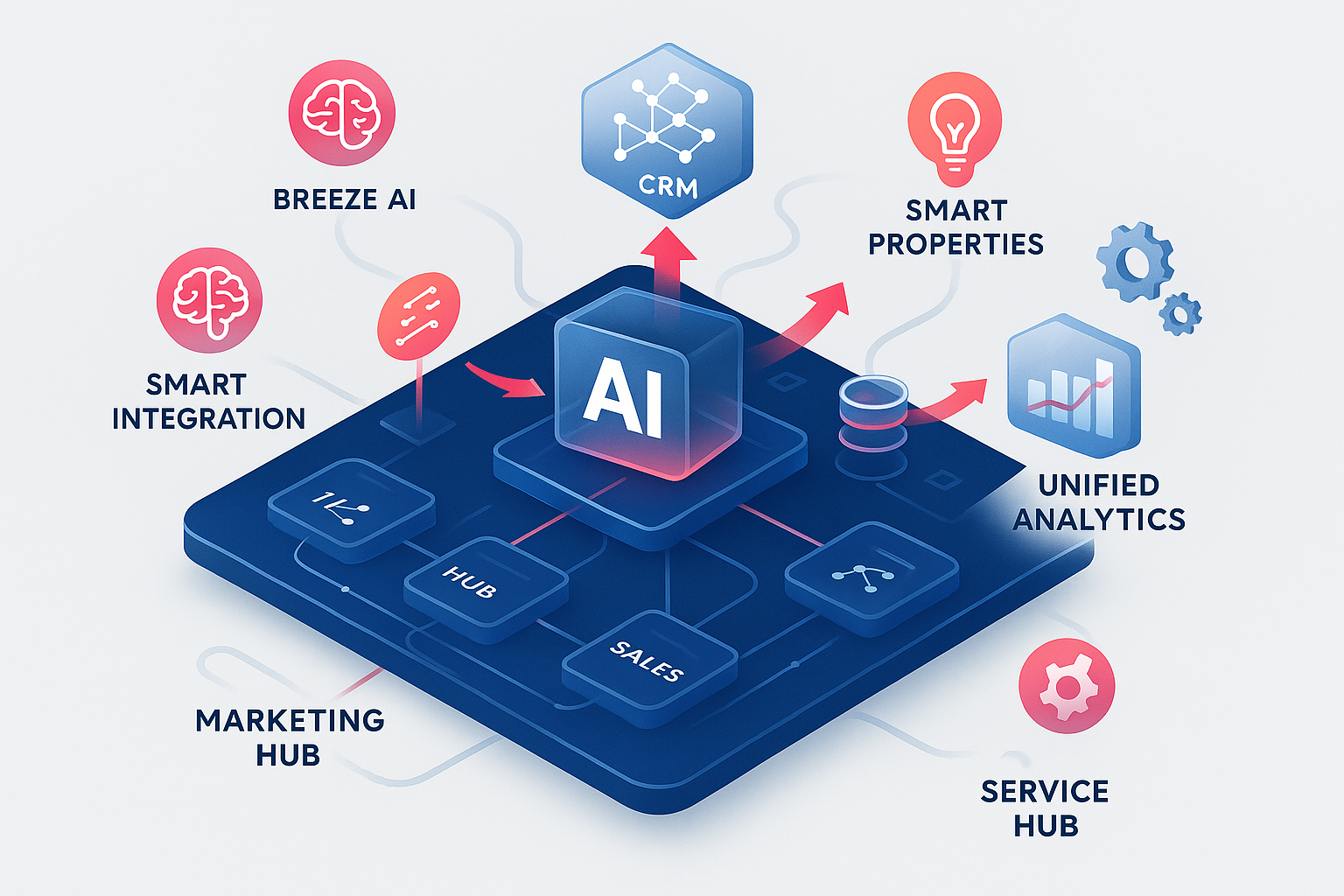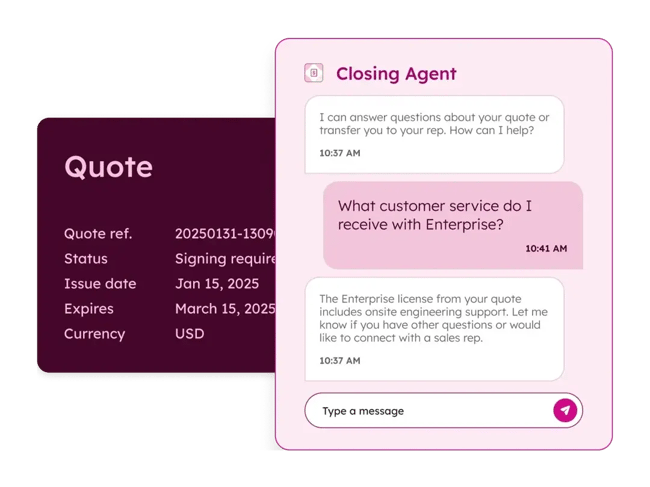HubSpot Spotlight 2025's announcement & feature breakdown

HubSpot Spotlight 2025 marked a seismic shift in how businesses approach customer relationship management. Gone are the days of fragmented data, repetitive manual tasks, and AI features that felt more experimental than practical. HubSpot has transformed into a true business operating system where artificial intelligence, unified data, and streamlined workflows deliver measurable results.
At Elixir Solutions, we've analyzed every announcement from INBOUND and Spotlight 2025 to understand what these updates mean for your business operations. This comprehensive guide breaks down the most impactful features, provides real-world implementation strategies, and gives you the insights needed to transform your CRM from a simple record-keeping tool into a revenue-generating powerhouse.
TABLE OVERVIEW
- What Makes HubSpot Spotlight 2025 Different
- Breeze AI Agents: AI in Daily Operations
- Data Hub & Data Studio: Centralizing and Connecting Information
- Sales Hub Enhancements: The Prospecting Agent
- Marketing Updates: Smarter Campaigns and Segmentation
- Service Hub AI: Smarter Customer Support
- Developer & Commerce Hub Improvements
- Implementation Strategy: What These Updates Mean for Different Business Types
- Conclusion
What Makes HubSpot Spotlight 2025 Different
Unlike previous updates that added isolated features, HubSpot Spotlight 2025 focuses on creating an integrated ecosystem. The platform now connects AI capabilities with unified data management to solve the fundamental challenges that have plagued growing businesses for years.
The core transformation addresses three critical pain points:
- Data fragmentation that creates information silos between teams
- Manual administrative tasks that prevent teams from focusing on growth activities
- AI tools that provide recommendations without understanding your specific business context
HubSpot's 2025 updates solve these problems through intelligent automation that learns from your business patterns and provides actionable insights based on your actual customer journey data
1. Data Hub & Data Studio: Centralizing and Connecting Information
Data fragmentation is one of the biggest challenges for growing businesses. HubSpot’s Data Hub and Data Studio help centralize, clean, and connect information across apps, creating a single source of truth.
Whether syncing with platforms like Snowflake, consolidating Salesforce and HubSpot revenue reports, or building analytics dashboards, businesses can now make faster, more confident decisions. Unified data also empowers AI tools to provide more accurate recommendations.
New Data Hub Features:
- Unified data integration from Salesforce, Snowflake, and custom databases
- Real-time data synchronization across all connected systems
- Data Studio provides visual dashboards that update automatically
- Advanced data mapping tools for complex system architectures
2. Breeze AI Agents: AI in Daily Operations
Breeze AI Agent represent HubSpot's vision of artificial intelligence as a practical business tool rather than a novelty. It handles routine administrative tasks while keeping humans in control of important strategic decisions.
Breeze AI can, for example, automatically summarize a customer service ticket, suggest next steps, and flag urgent issues, saving hours of manual review. Currently in public beta, Breeze signals HubSpot’s commitment to AI that actively supports teams instead of just providing static recommendations.
Core Breeze AI Capabilities:
- Automatic summarization of customer interactions across email, calls, and support tickets
- Context-aware follow-up suggestions based on conversation history
- Intelligent issue escalation and routing to appropriate team members
- Meeting preparation with AI-generated contact briefs
Customer service tickets arrive with AI-generated summaries of issues and suggested solutions. Sales follow-ups include relevant context about previous conversations and recommended next actions. Meeting preparation becomes automatic with briefings on contact history and current opportunities.
Managing AI Accuracy Expectations
While AI tools show promise, 85% of AI projects fail to deliver on their promises due to unrealistic expectations about AI capabilities. Between 70-85% of current AI initiatives fail to meet expected outcomes, often because organizations expect immediate results from systems that need time to learn.
Breeze AI considerations:
- AI summaries require human review for important interactions
- Accuracy improves over time as the system learns your business patterns
- Complex or nuanced situations may require human judgment
- Initial setup requires training the system on your specific processes

3. Sales Hub Enhancements: The Prospecting Agent
The new Prospecting Agent eliminates busy work that prevents sales teams from actual selling activities.
Sales AI Capabilities:
- Prospecting Agent identifies high-potential leads using behavioral signals
- Automatic contact information discovery and verification
- Intelligent outreach timing based on prospect engagement patterns
- Smart scheduling that coordinates across multiple participants and time zones
Sales representatives spend significantly less time researching prospects and more time having meaningful conversations. Outreach messages include context about why prospects fit your ideal customer profile. Follow-up timing optimizes based on individual prospect behavior patterns.
Sales AI works best when:
- You have a clearly defined ideal customer profile
- Sales processes are documented and consistent
- Sufficient historical data exists to identify successful patterns
- Team members understand when to trust AI suggestions versus human judgment
4. Marketing Updates: Smarter Campaigns and Segmentation
HubSpot Marketing Hub is now more AI-driven than ever. Smarter audience segmentation, campaign performance summaries, and tools like Content Remix allow marketers to repurpose high-performing content across multiple channels. AI-driven insights suggest optimization opportunities and highlight content that resonates most with your audience.
New Marketing & Content Hub Features:
- Loop: Loop Marketing is a new four-stage approach that combines AI efficiency and human authenticity to drive growth. It loops. It learns. It gets sharper every time you use it.
- Marketing Studio
- AI Powered Email
- Segmentation & Personalisation
- AI Engine optimization
5. Service Hub AI: Smarter Customer Support
Service teams benefit from AI-powered ticket summaries, reply recommendations, and urgency-based case prioritization.
These features reduce response times, improve customer satisfaction, and free teams to focus on strategic initiatives.
6. Developer & Commerce Hub Enhancements
Beyond AI, HubSpot’s platform upgrades also support developers and commerce teams:
- Developers gain expanded API access and more robust testing environments.
- Commerce Hub has now AI CPQ quoting

7. Implementation Strategy: What These Updates Mean for Different Business Types
Early-Stage Companies (Under 50 Employees)
These features provide maximum value when you have established processes and sufficient data. Focus on Smart CRM basics and simple automation before advanced AI features.
Recommended priorities:
- Basic CRM cleanup and standardization
- Simple automation workflows
- Gradual AI feature adoption as data volume grows
Growth-Stage Companies (50-500 Employees)
This is where HubSpot's 2025 features deliver optimal impact. You have enough data for AI learning, but sufficient growth potential to benefit from automation.
Key opportunities:
- Data Hub integration as tool stack expands
- AI-powered marketing segmentation and personalization
- Sales intelligence for scaling teams
Enterprise Organizations (500+ Employees)
Advanced integration capabilities and AI sophistication finally match enterprise requirements, though implementation complexity increases significantly.
Strategic advantages:
- Complex multi-system data unification
- AI-powered process automation at scale
- Advanced analytics and business intelligence
Conclusion
HubSpot Spotlight 2025 shows that the platform is evolving from a CRM into a full business operating system, integrating AI, data, and actionable insights across marketing, sales, and service. These updates help teams spend less time on repetitive tasks, make smarter decisions, and focus on what really drives growth.
The goal isn't to use every new feature, but to select capabilities that genuinely improve your business operations. Success comes from thoughtful implementation rather than feature adoption volume.
At Elixir Solutions, we’ve created a set of cheat sheets covering marketing, sales, service, and CRM, gathering all the key resources, prompts, and practical guidance in one place. They’re designed to help you put these updates into action quickly and effectively.
To get access to all the cheat sheets, click here.



